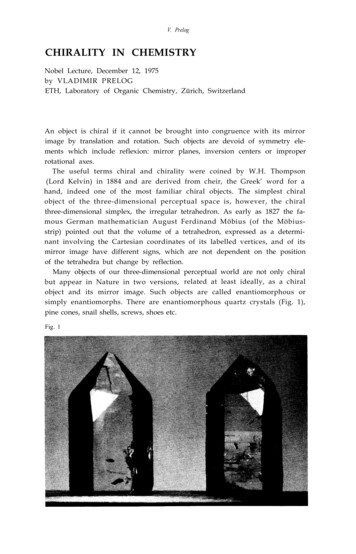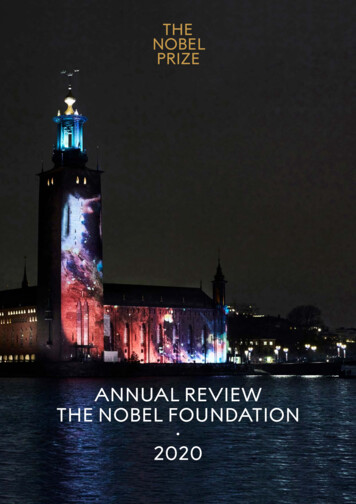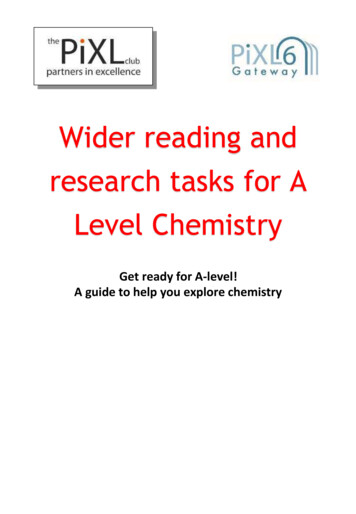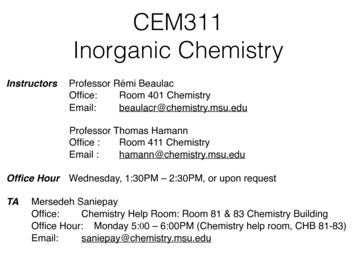
Transcription
s catalogue page contains onlymodels of familiar stereoisomers. However, some generalizations are possible.Tetrahedral asymmetric atoms are also called centers of asymmetry or chirality, but such centers are not necessarily occupied by an asymmetric atom (Fig.14). They can be occupied by atoms with rotational symmetry or the asymmetric atom can be replaced by a rigid atomic skeleton with tetrahedral symmetry such as the adamantane skeleton. The centre of the achiral skeleton of adamantane is a center of chirality which is not occupied by an atom.
214Chemistry 1975AFFGF FFFig. 14
V. Prelog215Van’t Hoff had already noticed that there are chiral molecules without centers of chirality and had postulated that allenes with the constitutional formula(AB)C C C(AB) are chiral. Models for such cases can be constructed byusing as the basic geometrical figure tetrahedra of lower symmetry than that ofa regular tetrahedron. Eight point-group symmetries (shown on fig. 15) arepossible for a tetrahedron. Three of them (Da, C2 and C1) are intrinsically chiral i.e. their chirality does not depend on how ligands occupy their vertices.The regular tetrahedron (T d ) itself and four others are achiral (D2 d , C3v ,C 2v amd C s). By occupying the vertices of such tetrahedra with all combinations of four ligands new pages of the catalogue are obtained. These newpages contain some types of stereoisomerism which had escaped the notice ofpragmatic stereochemists.
216Chemistry 1975I have limited the discussion to three-dimensional basic figures with 4ligands because they are typical for organic stereochemistry. The same procedures can be applied to produce catalogues based on figures with five or morevertices but the multiplicity of models so obtained is larger and therefore moredifficult to deal with in a lecture.The time at my disposition also does not permit me to deal with the manifold biochemical and biological aspects of molecular chirality. Two of thesemust be mentioned, however, briefly. The first is the fact that although mostcompounds involved in fundamental life processes, such as sugars and aminoacids, are chiral and although the energy of both enantiomers and the probability of their formation in an achiral environment are equal, only one enantiomer occurs in Nature; the enantiomers involved in life processes are the samein men, animals, plants and microorganisms, independent on their place andtime on Earth. Many hypotheses have been conceived about this subject, whichcan be regarded as one of the first problems of molecular theology. One possible explanation is that the creation of living matter was an extremely improbable event, which occured only once.The second aspect I would like to touch, the maintenance of enantiomericpurity, is less puzzling but nevertheless still challenging to chemists. Nature isthe great master of stereospecificity thanks to the ad hoc tools, the special catalysts called enzymes, that she has developed. The stereospecificity of enzymicreactions can be imitated by chemists only in rare cases. The mystery of enzymic activity and specificity will not be elucidated without a knowledge of theintricate stereochemical details of enzymic reactions. The protagonist in thisfield is John Warcup Cornforth.
science fiction book "Flatland" about 70 years ago. The simplest chiral fig-ure in "Flatland" is an irregular triangle, a scalene. A scalene can be located in a plane in two different ways so that it displays one or other of its two op- posite faces. Two equal scalenes "oriented" differently in a plane cannot be .










